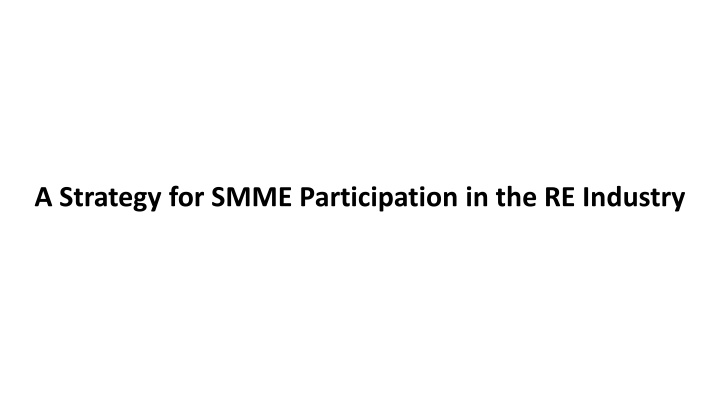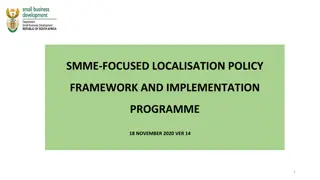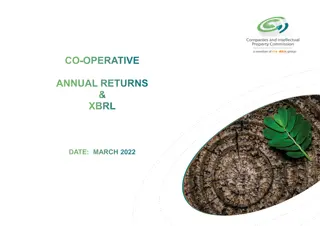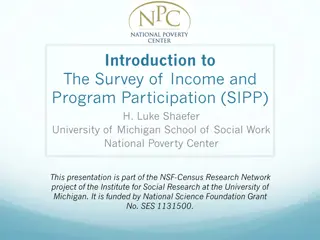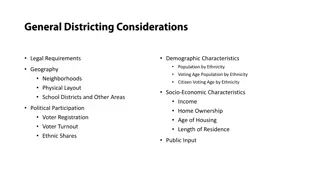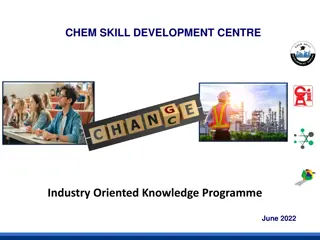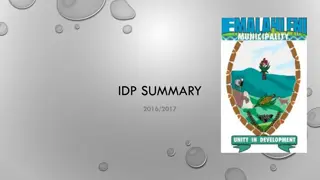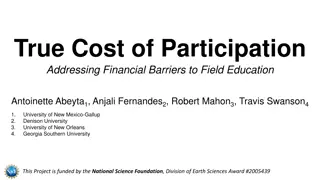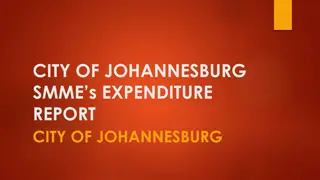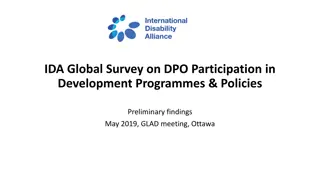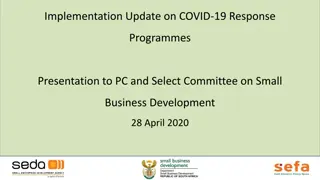A Strategy for SMME Participation in the RE Industry
This presentation outlines the challenges and opportunities for small, medium, and micro enterprises (SMMEs) in the renewable energy sector. It discusses the limited involvement of SMMEs in the Renewable Energy Independent Power Producer Procurement (REIPPP) program and proposes interventions to support their inclusion, particularly in the small-scale embedded generation market.
Download Presentation

Please find below an Image/Link to download the presentation.
The content on the website is provided AS IS for your information and personal use only. It may not be sold, licensed, or shared on other websites without obtaining consent from the author.If you encounter any issues during the download, it is possible that the publisher has removed the file from their server.
You are allowed to download the files provided on this website for personal or commercial use, subject to the condition that they are used lawfully. All files are the property of their respective owners.
The content on the website is provided AS IS for your information and personal use only. It may not be sold, licensed, or shared on other websites without obtaining consent from the author.
E N D
Presentation Transcript
Presentation outline Presentation outline Introduction and background Problem statement Research method Energy services market challenges and opportunities Proposed interventions Conclusion
Introduction and Background Introduction and Background There has been an increase in the uptake of RE (mostly solar) in SA as result of the REIPPP 6.5 GW of RE, at a total investment of R209 billion has been procured from 112 IPPs in 7 bid windows (BW 1 4; SBW 1S2 & 1 2S2) in the first decade of REIPPP (2011-21), and more than 50 % are located in the Northern Cape Province However, the REIPPP has had minimal impact in terms of the inclusion of SMMEs into the core VC of the RE sector despite Enterprise development commitment by IPP estimated at R320m per year for BW 1-4 over the 20 years life of a typical IPP project SMMEs often offer simple services to IPPs e.g. security, cleaning Alongside the REIPPP there has been growth in the small scale embedded generation (SSEG) as residential, commercial & industrial energy users search alternative of supply energy encouraged by (i) rising Eskom electricity cost & insecurity of supply (ii) supportive energy policies (iii) availability of innovative RE finance products (iv) falling prices of RE technologies NC Provincial Renewable Energy Conference resolution (October 2018) The inclusion of SMMEs in the RE industry be prioritised, and critical role of the Provincial Department of Economic Development and Tourism in strategy and implementation.
Problem statement Problem statement SMMEs participation in any industry contribute in economic growth and development. Some estimates suggests that in SA SSMEs constitute >90 % of formal business, provide employment to 50 60 % of the LF & contribute around 50 % to GDP (IFC, 2018) The main platform for RE in the Country is the REIPPP, however SMME participation is limited due to numerous challenges e.g. limited financial resources and lack technical & managerial capabilities (Mkhwebane, 2018) The bulk of the IPP projects are located in the NC province where radiation intensity in the country is highest > 50% (59 out the 112) Recent research indicate that there are realistic opportunities for SMMEs in the SSEG segment of the RE industry, albeit with some notable challenges that require targeted interventions by the state (Mkhwebane and Ntuli, 2019) Against this background and with a focus on the NC Province, this study proposes a set of intervention to circumvent some of the challenges to unlock the opportunities for SMMEs in the SSEG market
The Study approach The Study approach Desktop review of strategic documents and relevant literature (field studies) Assessment of strategic and periodic publications by the relevant role players (SALGA, GREEN CAPE, CSIR, industry associations e.g. SAPVIA, NERSA, Local governments,) Map the value chain activities and role players Understand the challenges and opportunities Identifying the relevant stakeholders for policy dialogue dialogue Dialogue forums with relevant stakeholders (virtual platforms): Provincial departments PT, R&PW Government agencies NC SMMEs Trust, SEDA, SAREBI, ICLEI Africa Funding institutions commercial banks Local government Sol Plaatje Local Municipality Industry associations SAPVIA Analysis Feedback collated and analysed Reporting R&D Raw Material Supply
What is SSEG? What is SSEG? Part of the broader RES market Distributed generation located at the sight of consumption i.e. residential & Candi Generation facilities >1MW Dominated by rooftop PV systems Decreasing cost of PV components Less costly to implement vs wind Easy of scalability LG Play a critical enabling role Currently 68 out of the 165 licensed municipal electricity distributors allow SSEG installations into their networks and 47 of these have an official application systems while 31 have NERSA approved SSEG tariffs Renewable Energy Services SSEG Energy Efficiency Energy Generation (Rooftop Solar PV) Retrofits for existing buildings Energy Storage Growing sector projected total capacity of 7.5GW by 2035 with estimated market value of R75bn (Green Cape, 2022)
Opportunities for SMMEs in SSEG (solar PV value chain) Opportunities for SMMEs in SSEG (solar PV value chain) R&D Raw Material Supply Manufacturing Distribution Installation O&M SMME can play a role in SSEG except R&D, raw material supply and manufacturing (Mkhwebane & Ntuli, 2019) Components are imported from China and Germany, assembled locally by the Investors, these are predominantly medium-sized enterprises and large companies due to the capital requirements to purchase and install the solar system. Opportunities available for SMMEs include: Installation either as the main contractor or under a sub-contract from an established firm Operation & maintenance as a service provider to the main contractor or directly to the customer
Challenges for SMMEs in SSEG Challenges for SMMEs in SSEG Lack of regulatory framework Steep Customer lose confidence on industry: unskilled contractors requirements: insurance, guarantees etc. Challenges in SSEG Lost opportunity: no manufacturing locally Industry is capital- intensive Lack of standards
Proposed intervention for SMME participation in SSEG in the NC (1of 2) Proposed intervention for SMME participation in SSEG in the NC (1of 2) The NC Department of Economic Development & Tourism is well positioned to coordinate the proposed intervention both the SMMEs sector and RE industry are priority focus areas of the Department. The intervention targets two types of renewable energy SMMEs at different stages of development: Aspiring entrepreneurs with viable business concept Entrepreneurs with trading businesses but facing growth and sustainability challenges. Installation, O&M of rooftop solar PV systems in all public buildings is a low-hanging opportunity with a high likelihood for immediate realisation. However, as mentioned earlier there are challenges facing emerging and aspiring SMMEs in the renewable energy sector to realise this opportunity. The challenges identified, indicate a multi-stakeholder approach, to resolve (including the Regulator, Municipalities, Funding Institutions, Government, SMMEs, Industry Associations)
Proposed intervention for SMME participation in SSEG in the NC (2of 2) Proposed intervention for SMME participation in SSEG in the NC (2of 2) The intervention is made up of 5 mutually supportive strategic interventions (SI) SI-1: Support specialised training of emerging and aspiring SMMEs. SI-2: Create an incentive fund & support package to stimulate entrepreneurship. SI-3: Establish & formalise partnerships with industry stakeholders. SI-4: Facilitate linkages between start-up/emerging SMMEs & established Escos SI-5: Facilitate access to government building to create the initial market Three intervention models (IM) IM-1: Promote incubators IM-2: Support a cluster approach IM-3: Facilitate mentoring and coaching
Key stakeholders and their roles Key stakeholders and their roles Provincial Departments Department of Economic Development and Tourism Department of Roads and Public Works Other Departments Other stakeholders Financial institutions-commercial banks and DFIs Industry associations-SAPVIA Government agencies-SEDA and the SAREBI SALGA Northern Cape local municipalities Sol Plaatje Local Municipality
Conclusion Conclusion RE is a difficult industry for SMME to participate high capital cost requirements and complex capabilities However, SSEG seems to be a platform that could be viable for SMME participation, to build skill and industry confidence through collaborations with medium-sized and larger companies Collaboration amongst the role players in the value chain is key to realise the opportunity
